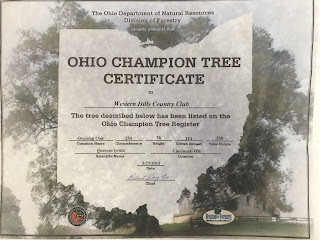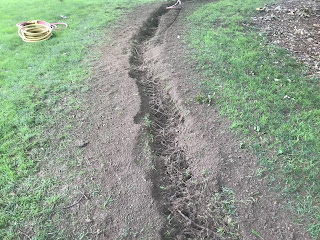The annual bluegrass weevil has been detected at many golf courses around the Tri-State area over the last couple of years and now we can add Western Hills Country Club to that list. ABW
was first discovered in the northeast in the 1930s and over the last 90 years
has typically only been a problem in that area of the country. However, they have now made their way to the Mid-West.
Annual bluegrass weevils are small black beetles that cause
significant damage to turf specifically annual bluegrass (poa annua) and
bentgrass. They feed on grass blades and crowns. The damage begins as small yellow patches in
the grass that turn brown later in the season. They cause significant plant desiccation
and can wipe out big areas of turf in a season. This insect was detected around some of the green collars and we are applying insecticides to control this pest. We will continue to scout for this insect and treat when/where appropriate.
 |
| Annual Bluegrass Weevil adult and larva. |
 |
| Early ABW damage on #7 collar |
 |
| ABW larva found on #7 collar |
After below average rain for the months of March, April, and May; June and July have been above normal. Our weather station has recorded 9" of rain from mid June to mid July, and we stand about an inch above normal for the year. All of this rain was great for giving our irrigation system a rest, but it kicks our spraying program into overdrive. We have been decreasing our spray intervals to stave off the summer-time diseases such as pythium blight, summer patch, brown patch, anthracnose, and dollar spot. Also, our plant growth applications have increased, especially on our green's spray program, to keep growth in check. This along with topdressing and verticutting has, so far, kept our green speeds consistent throughout the early summer months.
Now, heading into the latter part of the month, the dry, humid summer weather has replaced the tropical monsoons. The abundant amount of poa annua that permeates the golf course is showing signs of stress. When soil temperatures get above 95 degrees this grass plant taps out until cooler temperatures return. The other cool season grasses such as bentgrass, ryegrass, and to a lesser extent fescue, struggle as well, during these hot and dry days. Watering becomes difficult when the evapotransporation rate increases and sometimes we have to water multiple times a day to maintain proper moisture levels. You will also see us handwatering many localized dry spot areas. We will continue to do everything we can to keep turf alive during the hardest time of year to grow cool season grass; however, even with our best efforts some turf will be lost.
 |
| Irrigation precipitation report from the WHCC weather station for June 17th to July 17th. |
 |
| Golf cart damage #11 after driving over stressed turf during a hot summer afternoon. This is why "rough" days need to be implemented. |
 |
| Death of cool season grass due to summer heat |
For the Fourth of July, mother nature provided her own firework display and dropped lightning strikes like bombs around the golf course. Two pin oaks located by #7 green and #9 green got struck. The strike was so powerful that the bark on #7 pin oak blew over the green and into the fence across the cart path. Our irrigation system did not take the lightning well either and we had a couple computer boards fried and many blown fuses to replace. We are currently having both lightning struck trees being assessed by board certified master arborists to figure out if removal of these trees is warranted.
 |
| Lightning damage to #7 pin oak |
 |
| Up close picture of #7 oak. 50% of the trunk’s bark may have been damaged. This will weaken the tree’s structural integrity over time and open up the cambium layer to insects, weather, and diseases. |
There are many projects on the horizon with two projects currently taking place. A Verdin clock is being installed by #1 tee. The knee wall and pavers have been completed. Flowers were planted around the future site of the clock and the actual clock should be set in place by the end of August.
Also, lighting is being installed under the Ohio champion overcup oak tree. To protect this tree, an air spade was used to dig the trench for installing the light fixtures. If we would have dug the trench using a shovel or backhoe around 50% of this old oak's critical root area would have been lost, putting the tree under a tremendous amount of stress and ultimately leading to significant canopy die back or death. The use of an air spade kept the roots intact and the electrician was able to thread the wires bellow the roots for installation. Eight well lights were installed around the base of the tree. The lights are 120V fixtures with a medium base screw shell. They are manufactured by Coast 2 Coast lighting and are PAR 38 LED lamps, 30W (4000 lumens) with a 110 degree beam angel. The health of this signature champion overcup oak (biggest overcup oak in Ohio, and 6th biggest in the country) has been our #1 concern throughout this process and hopefully the lights will be enjoyed by all.
 |
Champion tree designation from Ohio department of forestry
|
 |
| Trench dug with air spade |
 |
| Notice how the tree roots are still intact |
 |
| Close up of lights in the early morning |
 |
| Lights at night |
 |
| Progress on Verdin clock project |
The end of August will be the beginning of other big changes coming to WHCC. The driving range tees will be getting an expansion, a new chipping green will be added, and the putting green will be expanded. Brian Huntley is the architect for these projects and the grounds department is excited to be a part of these upgrades. The first step will be to remove 20 trees located in the driving range to make way for these improvements. This will begin sometime in late July or early August. Then, starting August 16th, the renovation will ramp up, beginning with the spraying of 2 acres with glyphosate, removing existing irrigation heads, and mobilization. The following week Russ Macke will begin shaping. After that mother nature, labor, supply chains, and any unforeseen problems will dictate the pace of the renovation process. This will be a big project with many moving parts. Irrigation will have to be relocated and added, areas shaped, drainage and gravel installed, cart paths added and relocated, and sod/seed installed before colder temperatures arrive. We hope to have this phase of the project done by mid-October. Phase 2 will occur next year on the south end driving range tee.
Another project currently in the works is installing drainage to greens #4 and #8 and raising up the right side of #13 green. We are currently talking to Golf Preservations about this project and hopefully this will take place as the driving range renovation is slowing down.
 |
| Brian Huntley's driving range renovation design |
 |
| Putting green expansion |
 |
| Leibold irrigation plan for new driving range |
Since we may get bored in mid-fall when these projects wind down, we have decided to install a new golf cart building. It will house all of the golf carts and give us the current golf cart storage area. This will help us out immensely with storing the grounds equipment. Currently many of our expensive tractors are stored outside in the elements and having this area will allow us to place this equipment inside along with other important and expensive new equipment such as the new fairway verticutting unit. Other upgrades are needed for the grounds building including installation of a lift for better equipment access for repairs and maintenance, upgrading old lighting, and installing bins for grounds materials (sand, gravel, topsoil, mulch, etc.). The first step of this process was removing a big section of irrigation located parallel to the parking lot by #18, where the new building will be placed. In addition, the parking lot will be expanded where the current employee parking area is occupying. The irrigation located in this area was removed as well. The cutting/capping and sprinkler head removal was completed this week and is ready for the parking lot expansion that will take place in early August.
 |
| Irrigation area that has been cut and capped. Red lines are the capped locations. |
There are many changes ahead for the WHCC grounds. I will continue to update as these projects take shape. We ask for everyone's patience during this exciting time. Many of our workers will be busy with projects in the next couple of months. We will continue to keep the golf course in great shape as the year progresses; however there may be days when most of the crew will be busy with renovation tasks and some daily maintenance might have to be overlooked. Fingers crossed that everything will go as planned and we are excited about the changes coming!
Brad Piecuch
Grounds Superintendent





















